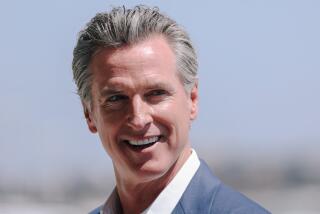Accord Brings Soccer Fields to Urban Park
- Share via
State and city officials have brokered a deal that will bring athletic fields to Taylor Yard near downtown Los Angeles, heading off a dispute over the future of the state’s urban parks that threatened to divide Latino activists, politicians and conservationists.
Under the agreement, to be announced Friday, California will lease half of the new 40-acre Taylor Yard state park to Los Angeles recreation officials, who will manage the soccer and baseball fields. The other half will be a more natural setting, possibly including a reconstructed wetlands area, that will tie the park to the adjacent Los Angeles River.
California parks officials disclosed last year that they had no intention of building or managing athletic fields on Taylor Yard, a former Union Pacific railroad maintenance depot in Cypress Park, part of which was bought by the state with voter-approved bond money.
That surprised and angered some local activists, who noted that months earlier, Gov. Gray Davis had posed for pictures at the park site with Latino boys and girls from Anahuak, a popular youth soccer league that had no fields to call its own.
Raul Macias, a Mexican immigrant who founded Anahuak and paid for children’s soccer shoes and uniforms out of his own pocket, said Wednesday he was elated that the fields would be built. It was a fight he had given up hopes of winning, he said.
“Isn’t it so beautiful?” Macias said excitedly in Spanish. “Imagine how many children are going to play there. Last night, I could not sleep thinking about it.”
The new agreement -- negotiated over several months by Assemblywoman Jackie Goldberg (D-Los Angeles), state Sen. Gil Cedillo (D-Los Angeles), Councilman Ed Reyes, state parks Director Ruth Coleman and Mayor James K. Hahn’s office -- permits the city to run the fields while allowing the state parks department to maintain its stance that its mission is to manage scenic places, not run recreation centers.
Cedillo, Goldberg and others had threatened to change that mission with legislation, arguing that it was out of date for a state that is increasingly building parks in urban centers with bond money approved by inner-city voters. The deal is still contingent on passage of a measure by Goldberg, AB 413, because it enables the state to lease the land to the city for 25 years.
“The community meetings that we were a part of, everybody said they wanted both active and passive” uses for the park site, Goldberg said. “The state and the city have found a way to make that happen, and I am overjoyed. There will be places to walk and sit and have a quiet respite from the asphalt and concrete, and there will also be a place for the Anahuak soccer club and other sports groups to do their thing.”
Goldberg cautioned that not every urban park dispute can -- or should -- have the same outcome, however.
“It will be a case-by-case basis, to be honest,” she said. “I think there are some places where it just doesn’t make sense to have active space.”
Reyes, who grew up in Cypress Park, hailed the deal as a victory for the working-class neighborhoods near Taylor Yard. He said the area has historically been ignored by city and state officials who turned the riverside district into a repository for industrial plants and maintenance centers that never would have been allowed in wealthier parts of the city.
“We are finally creating a place at the table for the community. Their priorities are the ones we work for,” Reyes said. “They are going to get their soccer fields, and the families that do not have diversion opportunities are going to get a chance to do something productive. The greater those opportunities, the better chance we have to defeat those who want to push them into gangs and drugs.”
Although the park will have two distinct functions, officials plan to have the passive and active sides blend seamlessly together, said California parks spokesman Roy Stearns. He also stressed that community groups would still have a say over many of the detailed features of the park, which is not set to open until 2005.
“This is a tremendous partnership for Los Angeles,” Gov. Davis said through a spokesman.
“This investment in inner-city open space will bring enjoyment and prosperity to park users for generations to come.”
More to Read
Sign up for Essential California
The most important California stories and recommendations in your inbox every morning.
You may occasionally receive promotional content from the Los Angeles Times.










